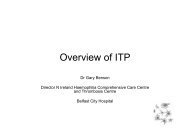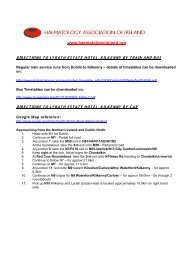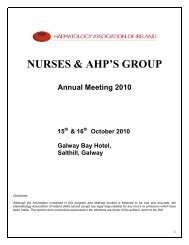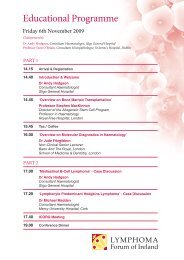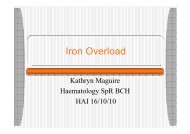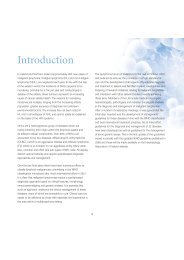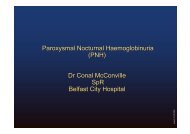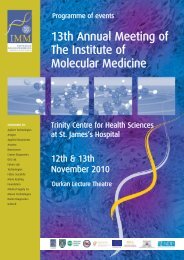Guidelines on Diagnosis and Treatment of Malignant Lymphomas
Guidelines on Diagnosis and Treatment of Malignant Lymphomas
Guidelines on Diagnosis and Treatment of Malignant Lymphomas
You also want an ePaper? Increase the reach of your titles
YUMPU automatically turns print PDFs into web optimized ePapers that Google loves.
Angioimmunoblastic<br />
T-Cell Lymphoma<br />
Definiti<strong>on</strong> <strong>and</strong> Incidence<br />
Angioimmunoblastic T-Cell Lymphoma, AILT (formerly AILD) is a<br />
peripheral T-cell lymphoma characterised by systemic symptoms,<br />
a polymorphous infiltrate involving lymph nodes, with a prominent<br />
proliferati<strong>on</strong> <strong>of</strong> high endothelial venules <strong>and</strong> follicular dendritic<br />
cells. It occurs in the middle aged <strong>and</strong> elderly, with an equal<br />
incidence in males <strong>and</strong> females.<br />
ICD-O Code 9705/3<br />
Clinical Presentati<strong>on</strong><br />
Patients usually present with B symptoms, generalised peripheral<br />
lymphadenopathy, hepatosplenomegaly, <strong>and</strong> frequent skin rash.<br />
The b<strong>on</strong>e marrow is comm<strong>on</strong>ly involved. Para-neoplastic<br />
manifestati<strong>on</strong>s are comm<strong>on</strong> <strong>and</strong> include skin rashes, autoimmune<br />
haemolytic anaemia, hypergammaglobulinaemia, eosinophilia,<br />
vasculitis, <strong>and</strong> haemophagocytosis. The clinical course is<br />
aggressive, with a median survival <strong>of</strong> less than 3 years.<br />
Pathology <strong>and</strong> Genetics<br />
The lymph node architecture is partially effaced, <strong>and</strong> regressed<br />
follicles are <strong>of</strong>ten present. The paracortex is diffusely infiltrated by<br />
a polymorphous populati<strong>on</strong> <strong>of</strong> medium-sized lymphocytes, usually<br />
with clear to pale cytoplasm <strong>and</strong> distinct cell membranes. The<br />
lymphocytes show minimal cytological atypia, <strong>and</strong> this form <strong>of</strong><br />
lymphoma may be difficult to distinguish from atypical T-z<strong>on</strong>e<br />
hyperplasia. The abnormal lymphoid cells are admixed with small,<br />
reactive lymphocytes, eosinophils, plasma cells <strong>and</strong> histiocytes.<br />
There is marked proliferati<strong>on</strong> <strong>of</strong> high endothelial venules <strong>and</strong><br />
follicular dendritic cell meshworks are <strong>of</strong>ten increased. Increased<br />
numbers <strong>of</strong> B immunoblasts are usually present in the paracortex.<br />
Immunophenotype<br />
The infiltrates are composed <strong>of</strong> mature T-cells, usually with an<br />
admixture <strong>of</strong> CD4 <strong>and</strong> CD8 cells, with CD4 cells usually outnumbering<br />
CD8 cells. Follicular dendritic cells (CD21+) are<br />
prominent. The neoplastic T-cells may aberrantly express CD10.<br />
Genetics<br />
T-cell receptor genes are rearranged in 75% <strong>of</strong> cases.<br />
Immunoglobulin gene rearrangement is present in 20-30%,<br />
correlating with cl<strong>on</strong>ally exp<strong>and</strong>ed EBV+ B cells. Gene expressi<strong>on</strong><br />
studies c<strong>on</strong>firm that the neoplastic cells are CD4+ TFH type.<br />
Staging<br />
As for other aggressive lymphomas.<br />
Recommended Investigati<strong>on</strong>s<br />
As for other aggressive lymphomas.<br />
Potential Pitfalls<br />
Failure to diagnose lymphoma in the c<strong>on</strong>text <strong>of</strong> a clinical<br />
presentati<strong>on</strong> characterised by a pr<strong>of</strong>ound immune disturbance.<br />
<strong>Treatment</strong><br />
<strong>Treatment</strong> opti<strong>on</strong>s include CHOP or CVP-like regimens,<br />
depending <strong>on</strong> patient age <strong>and</strong> co-morbidity. There is a high<br />
initial resp<strong>on</strong>se rate with these approaches, but early relapse or<br />
progressi<strong>on</strong> is comm<strong>on</strong> <strong>and</strong> there are few l<strong>on</strong>g-term survivors.<br />
L<strong>on</strong>g term disease c<strong>on</strong>trol may be achieved with weekly<br />
methotrexate <strong>and</strong> prednisol<strong>on</strong>e. High dose therapy <strong>and</strong><br />
autologous SCT have been reported by the EBMT to results<br />
in a 5 year 60% disease free survival.<br />
Resp<strong>on</strong>se Evaluati<strong>on</strong> <strong>and</strong> Follow Up<br />
As for other aggressive lymphomas.<br />
56



